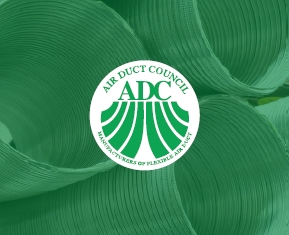
Benefits of
Membership
Become a Member of the Air Duct Council
If your company manufacturers flexible duct: become an Active Member.
If your company supplies flexible duct manufacturers: become an Associate Member.
ADC Active Membership
ADC Active Membership is open to companies in North America that manufacturer flexible air duct and flexible air connectors tested and listed in accordance with Underwriters Laboratories Standard for Factory-Made Air Ducts and Air Connectors (UL 181) and conforming to the National Fire Protection Association Standards 90A and 90B.
Only active members have voting rights within the organization. Special projects or programs may, from time to time, require special assessment funding. Active member special assessments are calculated on a scale based on members’ sales volume bracket as reported annually to ADC.
Active Membership Benefits:

Membership Meetings
ADC active members have the opportunity to meet two times each year. The ADC Fall Membership Meeting is generally held in October or November in the conjunction with the convention sponsored by Heating, Air Conditioning & Refrigeration Distributors International (HARDI, formerly NHRAW).
The ADC Spring Membership Meeting is generally held midweek in May. The location varies and the site is selected by a vote of the members. The evening before the meeting, the ADC associate members sponsor a reception and dinner. These evening events are an opportunity to meet your suppliers, potential suppliers, and fellow flexible duct manufacturers. The ADC often schedules a golf outing on the Thursday morning following the meeting. Top of FormUpcoming ADC Meetings

Website Listing
Active members are listed and linked on the official ADC website, www.flexibleduct.org. Company logo, key personnel contacts, email addresses, etc., are shown.

Printed Membership Directory
Active members receive updated copies of the ADC Active Member Directory and Associate Member Directory twice yearly.

Statistics Program
Active members may voluntarily participate in a quarterly statistics reporting program, which gathers flexible duct footage sales by commodity type. See the sample Quarterly Statistics Reporting Form for categories.
Each participating company is furnished a reporting so data remains confidential. Only ADC staff see these reports and are responsible for compiling, tabulating, and issuing the reports. Only participating companies receive a copy. These reports are an excellent planning and forecasting tool for flexible duct manufacturers, as they show sales and production trends.

Thermal Performance Certification Program
The ADC determined early in its formation that flexible duct R-values needed to be consistent throughout the industry. (In the early days of insulated flexible duct, each manufacturer used their own methods and test standards, which caused confusion in the marketplace.) With the assistance of UL and the ETL, the ADC created the Thermal Performance Program for R-value ratings in 1993. This program includes testing of product, classifying each insulation thickness and density by R-Value, and follow-up testing of the product R-Values at both the insulation manufacturer and the flexible air duct manufacturer. This method was designed to keep the industry “honest and standardized” when publishing R-values.
The ADC method ensures that inner core films, vapor barriers or other non-insulation components cannot be used to determine an ADC member R-value. The ADC test method measures the R-value of the insulation only. Most building codes today recognize and enforce the need for a standard flexible duct R-Value test. Many mechanical codes include language that duct insulation R-Values be based on insulation only.
How do you know if a flexible duct meets the R-Value required by building codes, engineers and contractors? Look for the ADC Thermal Performance Seal of Certification prominently displayed on the vapor-barrier of your insulated flex duct.

Become an ADC Active Member
If your company manufacturers flexible duct: become an Active Member.